The Intel Ivy Bridge (Core i7 3770K) Review
by Anand Lal Shimpi & Ryan Smith on April 23, 2012 12:03 PM EST- Posted in
- CPUs
- Intel
- Ivy Bridge
Quick Sync Image Quality & Performance
Intel obviously focused on increasing GPU performance with Ivy Bridge, but a side effect of that increased GPU performance is more compute available for Quick Sync. As you may recall, Sandy Bridge's secret weapon was an on-die hardware video transcode engine (Quick Sync), designed to keep Intel's CPUs competitive when faced with the onslaught of GPU computing applications. At the time, video transcode seemed to be the most likely candidate for significant GPU acceleration so the move made sense. Plus it doesn't hurt that video transcoding is an extremely popular activity to do with one's PC these days.
The power of Quick Sync was how it leveraged fixed function decode (and some encode) hardware with the on-die GPU's EU array. The combination of the two resulted in some pretty incredible performance gains not only over traditional software based transcoding, but also over the fastest GPU based solutions as well.
Intel put to rest any concerns about image quality when Quick Sync launched, and thankfully the situation hasn't changed today with Ivy Bridge. In fact, you get a bit more flexibility than you had a year ago.
Intel's latest drivers now allow for a selectable tradeoff between image quality and performance when transcoding using Quick Sync. The option is exposed in Media Espresso and ultimately corresponds to an increase in average bitrate. To test image quality and performance, I took the last Harry Potter Blu-ray, stripped it of its DRM and used Media Espresso to make it playable on an iPad 2 (1024 x 768 preset).
In the case of our Harry Potter transcode, selecting the Better Quality option increased average bitrate from to 3.86Mbps to 5.83Mbps. The resulting file size for the entire movie increased from 3.78GB to 5.71GB. Both options produced a good quality transcode, picking one over the other really depends on how much time (and space) you have as well as the screen size of the device you'll be watching it on. For most phone/tablet use I'd say the faster performing option is ideal.

| Intel Core i7 3770K (x86) | Intel Quick Sync (SNB) | Intel Quick Sync (IVB) | Intel Quick Sync, Better (IVB) | NVIDIA GeForce GTX 680 | AMD Radeon HD 7970 |
| original | original | original | original | original | original |
While AMD has yet to enable VCE in any publicly available software, NVIDIA's hardware encoder built into Kepler is alive and well. Cyberlink Media Espresso 6.5 will take advantage of the 680's NVENC engine which is why we standardized on it here for these tests. Once again, Quick Sync's transcoding abilities are limited to applications like Media Espresso or ArcSoft's Media Converter—there's still no support in open source applications like Handbrake.
Compared to the output from Quick Sync, NVENC appears to produce a softer image. However, if you compare the NVENC output to what we got from the software/x86 path you'll see that the two are quite similar. It seems that Quick Sync, at least in this case, is sharpening/adding more noise beyond what you'd normally expect. I'm not sure I'd call it bad, but I need to do some more testing before I know whether or not it's a good thing.
The good news is that NVENC doesn't pose any of the horrible image quality issues that NVIDIA's CUDA transcoding path gave us last year. For getting videos onto your phone, tablet or game console I'd say the output of either of these options, NVENC or Quick Sync, is good enough.
Unfortunately AMD's solution hasn't improved. The washed out images we saw last year, particularly in dark scenes prior to a significant change in brightness are back again. While NVENC delivers acceptable image quality, AMD does not.
The performance story is unfortunately not much different from last year either. The chart below is average frame rate over the entire encode process.
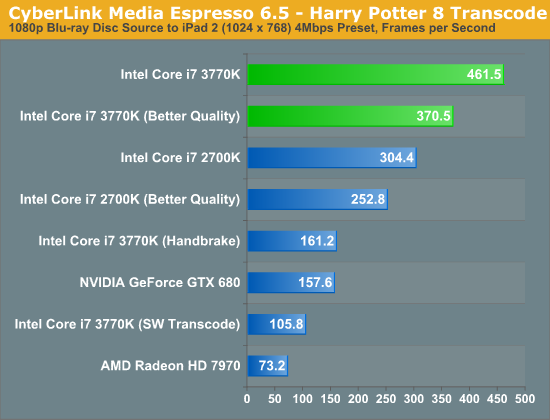
Just as we saw with Sandy Bridge, Quick Sync continues to be an incredible way to get video content onto devices other than your PC. One thing I wanted to make sure of was that Media Espresso wasn't somehow holding x86 performance back to make the GPU accelerated transcodes seem much better than they actually are. I asked our resident video expert, Ganesh, to clone Media Espresso's settings in a Handbrake profile. We took the profile and performed the same transcode, the result is listed above as the Core i7 3770K (Handbrake). You will notice that the Handbrake x86/x264 path is definitely faster than Cyberlink's software path, by over 50% to be exact. However even using Handbrake as a reference, Quick Sync transcodes over 2x faster.
In the tests below I took the same source and varied the output quality with some custom profiles. I targeted 1080p, 720p and 480p at decreasing average bitrates to illustrate the relationship between compression demands and performance:
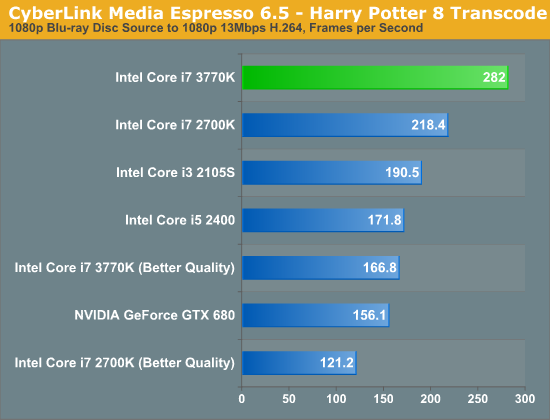
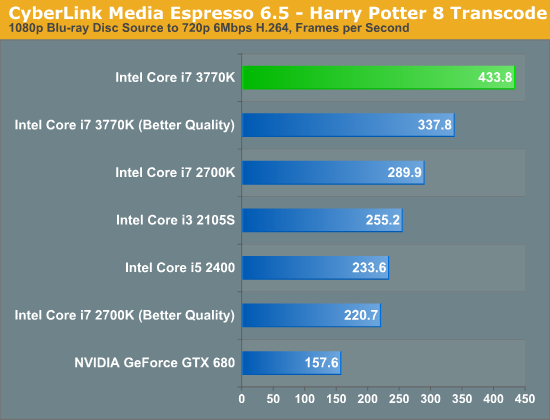

Unfortunately NVENC performance does not scale like Quick Sync. When asked to preserve a good amount of data, both NVENC and Quick Sync perform similarly in our 1080p/13Mbps test. However ask for more aggressive compression ratios for lower resolution/bitrate targets, and the Intel solution quickly distances itself from NVIDIA. One theory is that NVIDIA's entropy encode block could be the limiting factor here.
Ivy Bridge's improved Quick Sync appears to be aided both by an improved decoder and the HD 4000's faster/larger EU array. The graph below helps illustrate:
If we rely on software decoding but use Intel's hardware encode engine, Ivy Bridge is 18% faster than Sandy Bridge in this test (1080p 13Mbps output from BD source, same as above). If we turn on both hardware decode and encode, the advantage grows to 29%. More than half of the performance advantage in this case is due to the faster decode engine on Ivy Bridge.


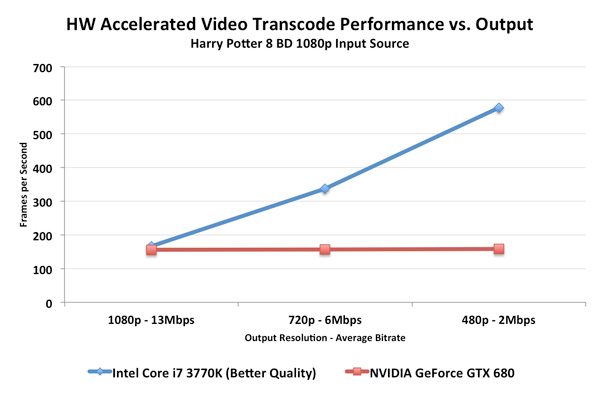
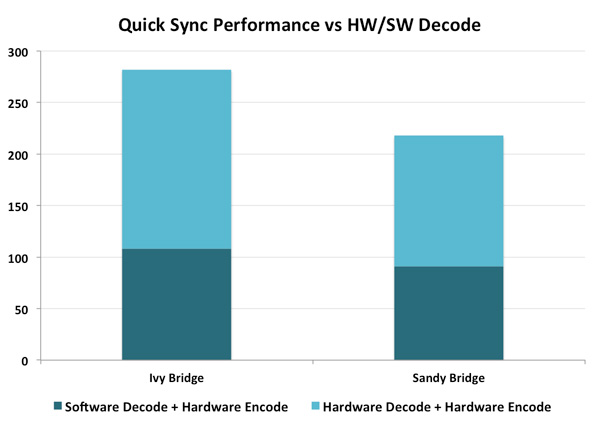








173 Comments
View All Comments
bman212121 - Monday, April 23, 2012 - link
Does anyone know which motherboards are going to support VT-d? Is there a specific chipset you'll need to have or will it just be up to the vendor to decide?Thanks,
Bman
Magichands8 - Monday, April 23, 2012 - link
I feel so ambivalent about Intel's current strategy. I admit I really don't understand why laptops are moving ahead so significantly. Why on earth would someone want to buy a laptop to replace a home desktop system? And if they aren't doing that then how can Intel justify a move away from the high performance end of the spectrum? If you really need to do business work away from home AND away from work then I can see the need for the mobility that a laptop can provide but this focus on a gaming-centric platform so that people can one day soon play Crisis on their laptop at traffic stops on the way to work is utterly baffling to me. On the other hand, the process technology and architectural improvements we are seeing are amazing. It just burns me that performance for what I use a desktop for is essentially at a standstill now so that Intel can save this unfathomable laptop crowd a few watts during the occasional vacation. As it stands when I see a review like this at first I'm like "Oh wow!" and then I feel cheated for having waited for Intel's latest and greatest. Ivy Bridge-E and Haswell-E better be mind blowing or I'm going to be completely crestfallen at the direction that Intel is taking.Quantumbytes - Monday, April 23, 2012 - link
Intel is following a strategy that will in the end provide compute power for small and powerfull devices like cell phones, laptops, tablets, RFIDs, food and apparel tags, etc. They are looking at the big picture and the money is in the small designs. Desktops are a means to an end. Get used to the push to small and simple.JarredWalton - Monday, April 23, 2012 - link
Thanks for being an AMD apologist and reading with blinders. Trinity will probably maintain the GPU performance gap. Until Trinity arrives, however, IVB HD 4000 on laptops on average across 15 games is equal to Llano A8 on laptops.And what other things are people doing with graphics besides games? Video transcoding? Okay, there's one task. Name another that computer users do on a regular basis. [Crickets...]
So why is Intel putting so much effort into graphics? Because their business is to sell you a new microprocessor every 2-3 years if they can. With the ability to put 1.4 billion transistors into a 130mm^2 die, what else are they supposed to do? More cache? More CPU cores? You try to make the worst aspect of your product better, and then you market it to the masses. That's all that's really happening here.
frozentundra123456 - Monday, April 23, 2012 - link
Most Llano laptops I have seen are not even the A8 model, but mostly the A6, with somewhat lower graphics capabilities. So I think you are being very fair to AMD in comparing their top of the line graphics to HD4000, instead of the lower performance A6 graphics.André - Monday, April 23, 2012 - link
"Unfortunately at the time only Apple was interested in a hypothetical Ivy Bridge GT3 and rumor has it that Otellini wasn't willing to make a part that only one OEM would buy in large quantities. We will eventually get the GPU that Apple wanted, but it'll be next year, with Haswell GT3. And the GPU that Apple really really wanted? That'll be GT4, with Broadwell in 2014."Can't help but wonder were you got this tidbit from? :-)
Very interesting.
André - Monday, April 23, 2012 - link
D'oh ... spelling.Where you got the tidbit from even.
SC-D_E_A_T_H - Monday, April 23, 2012 - link
I'll be sticking with my AMD Sempron 3400+. A processing badass!DanNeely - Monday, April 23, 2012 - link
"How many enthusiasts who overclock their computers are going to be running them *at full load* 24/7? None. "I do. The 30W difference at stock would be ~$40/year directly (13c/kwh); and probably twice that indirectly since my LL pays for heat during the winter, but the AC bills all mine. Vs my current x58 boxes, probably another factor of 1.5-2x; although unless OC levels creep up over the next few months I'm tempted to just wait and hope haswell doesn't burn all its improvements on the IGP and lower TDP for mobile.
Malih - Monday, April 23, 2012 - link
Somehow I'm no longer hungering for the top performance CPU.CPU performance has somewhat exceed most people daily needs (and mine too), and mobile CPUs are more exciting today, especially if they can help the system to consume less battery and have better graphics. I think its now safe enough for manufacturer like for example Apple to go for Trinity instead of Ivy Bridge for their MB Air, provided Trinity can be made to consume minimal power.